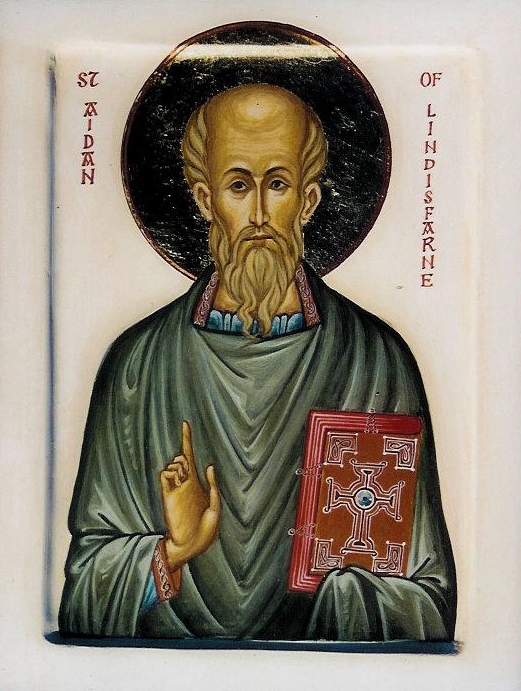Saint Aidan
31 Αυγούστου 2011
During the seventh century Northumbria, comprising the kingdoms of Bernicia and Deira, was a battleground in which the fate of rival kings determined whether the Celtic or the Roman Church should be the prevailing missionary influence. In 616, when King Ethelfrith of Northumbria was defeated in battle and slain, his son Oswald took refuge in Scotland and was converted to Christianity at Iona. Edwin, the new king, also became a Christian, but under the influence of Saint Paulinus, bishop of York, whose allegiance was to Rome. After Edwin’s death in 633, Paulinus abandoned his work in northern England. Oswald returned from exile and eventually became king, whereupon he sent to Iona for a bishop who would preach the gospel in Northumbria.
The first Celtic bishop, Corman, soon returned to Iona, where he declared that the Angles of Northumbria were too stubborn and intractable. The historian Bede writes that, at a meeting to discuss the problem, an Irish monk called Aidan suggested that Corman had been unreasonably harsh with his unlearned listeners, and “did not first, as the Apostle has told us, offer them the milk of less solid doctrine”. It was immediately resolved to send Aidan to Northumbria as bishop.
Little is known of the saint’s early life, save that he may have studied under Saint Senan on Scattery Island, Co. Clare. He arrived in Northumbria c. 635, and with Oswald’s consent made his headquarters on the offshore island of Lindisfarne, close to Oswald’s castle at Bamburgh. It was a fruitful partnership, with Oswald having on occasion to interpret the words of Aidan, who lacked fluency in the English language.
When Oswald was killed in battle in 642, Aidan worked equally well with Oswin, king of Deira. Aidan preached widely throughout Northumbria, travelling on foot, so that he could readily talk to everyone he met. When Oswin gave him a horse for use in difficult terrain, Aidan quixotically gave it to a beggar soliciting alms. Oswin was angry until, as Bede recounts, Aidan asked if the son of a mare was more precious to the king than a son of God. Oswin sought Aidan’s pardon, and promised never again to question or regret any of his wealth being given away to children of God. Both Oswald and Oswin are venerated in England as saints and martyrs.
Scores of Scottish and Irish monks assisted Aidan in his missionary work, building churches and spreading Celtic Christian influence to a degree that Lindisfarne became the virtual capital of Christian England. The saint also recruited classes of Anglo-Saxon youths to be educated at Lindisfarne. Among them was Saint Eata, abbot of Melrose and later of Lindisfarne. In time, Eata’s pupil, Saint Cuthbert, also became bishop of Lindisfarne.
Aidan lived a frugal life, and encouraged the laity to fast and study the scriptures. He himself fasted on Wednesdays and Fridays, and seldom ate at the royal table. When a feast was set before him he would give the food away to the hungry. The presents he received were given to the poor or used to buy the freedom of slaves, some of whom entered the priesthood. During Lent Aidan would retire to the small island of Farne for prayer and penance. While there in 651, he saw smoke rising from Bamburgh, which was then under attack by the pagan King Penda of Mercia. He prayed for the wind to change, and many of the besiegers were destroyed by fire.
When Oswin was killed in 651 by his treacherous cousin Oswy, king of Bernicia, Aidan was grief-stricken. The saint outlived Oswin by a mere twelve days, dying in a shelter he had erected against the wall of his church in Bamburgh.
From the Appletree Press title: A Little Book of Celtic Saints.




